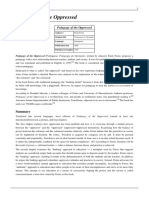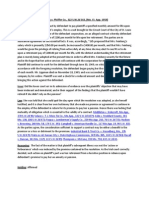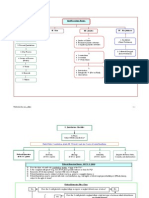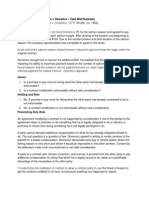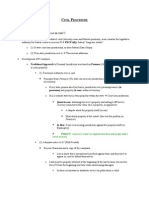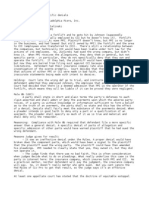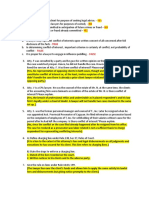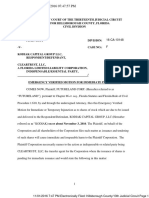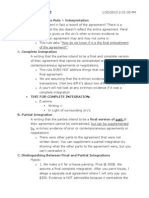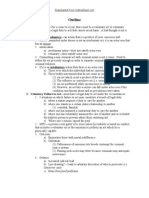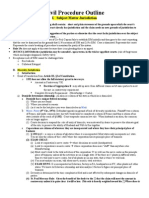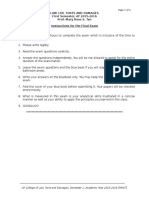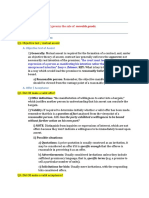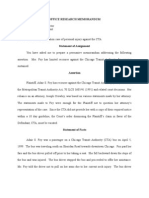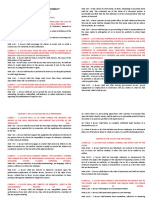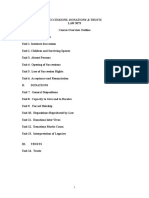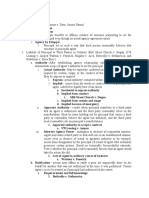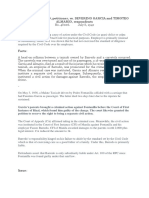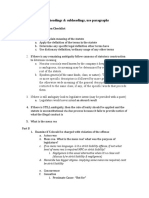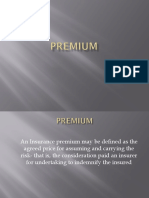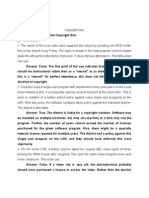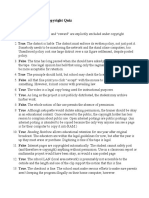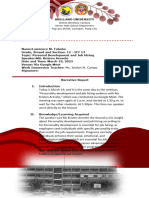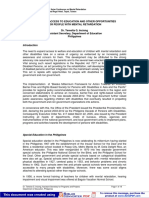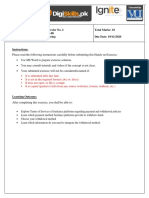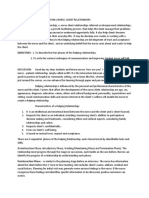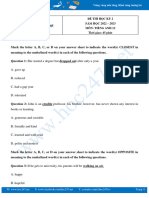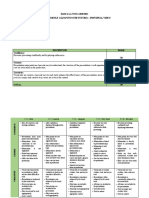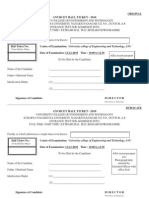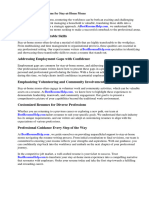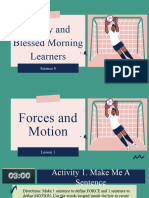0 ratings0% found this document useful (0 votes)
276 viewsCopyright Quiz Answers
Copyright Quiz Answers
Uploaded by
api-307337824This document contains 20 scenarios and determines whether each scenario involves a copyright violation or fair use. The majority involve copyright violations for using copyrighted works without permission or licensing, while some qualify as fair use for educational purposes within certain limits. Fair uses include using short clips for instruction, student work remaining in portfolios, public Internet content used for education, and works used at educator conferences within a year of broadcast. Violations occur when using entire works, distributing beyond intended audiences, or using content long-term without purchasing rights.
Copyright:
© All Rights Reserved
Available Formats
Download as DOCX, PDF, TXT or read online from Scribd
Copyright Quiz Answers
Copyright Quiz Answers
Uploaded by
api-3073378240 ratings0% found this document useful (0 votes)
276 views2 pagesThis document contains 20 scenarios and determines whether each scenario involves a copyright violation or fair use. The majority involve copyright violations for using copyrighted works without permission or licensing, while some qualify as fair use for educational purposes within certain limits. Fair uses include using short clips for instruction, student work remaining in portfolios, public Internet content used for education, and works used at educator conferences within a year of broadcast. Violations occur when using entire works, distributing beyond intended audiences, or using content long-term without purchasing rights.
Original Title
copyright quiz answers
Copyright
© © All Rights Reserved
Available Formats
DOCX, PDF, TXT or read online from Scribd
Share this document
Did you find this document useful?
Is this content inappropriate?
This document contains 20 scenarios and determines whether each scenario involves a copyright violation or fair use. The majority involve copyright violations for using copyrighted works without permission or licensing, while some qualify as fair use for educational purposes within certain limits. Fair uses include using short clips for instruction, student work remaining in portfolios, public Internet content used for education, and works used at educator conferences within a year of broadcast. Violations occur when using entire works, distributing beyond intended audiences, or using content long-term without purchasing rights.
Copyright:
© All Rights Reserved
Available Formats
Download as DOCX, PDF, TXT or read online from Scribd
Download as docx, pdf, or txt
0 ratings0% found this document useful (0 votes)
276 views2 pagesCopyright Quiz Answers
Copyright Quiz Answers
Uploaded by
api-307337824This document contains 20 scenarios and determines whether each scenario involves a copyright violation or fair use. The majority involve copyright violations for using copyrighted works without permission or licensing, while some qualify as fair use for educational purposes within certain limits. Fair uses include using short clips for instruction, student work remaining in portfolios, public Internet content used for education, and works used at educator conferences within a year of broadcast. Violations occur when using entire works, distributing beyond intended audiences, or using content long-term without purchasing rights.
Copyright:
© All Rights Reserved
Available Formats
Download as DOCX, PDF, TXT or read online from Scribd
Download as docx, pdf, or txt
You are on page 1of 2
Copyright Quiz
1. Copyright Violation. This would not be considered fair use
because the video is being used for entertainment purposes.
They would need to get a version that has been licensed for this
particular kind of use.
2. Copyright Violation. The district is definitely liable because
they should have been enforcing their written district policy
where it states that using single-user programs on the LAN is a
violation. There needs to be someone who monitors the network
and all of the individual teachers computers as well.
3. Copyright Violation. Although it was publicly broadcasted, this
is not fair use because she used the entire news program. Also,
she did not ask for permission to use the ABC news report. She
could have simply purchased it if she were going to use it for that
many consecutive years.
4. Fair Use. While the program would prefer there to be licenses
for each computer, I believe this would be permissible as long as
the principle carefully monitors its use. I think it would be awfully
difficult to make sure that only one class was using it at a time.
5. Copyright Violation. Purchasing a computer program and
licensing it are two entirely different things. Normally, the fine
print explains this to the user when the program is first opened.
6. Fair Use. Since the teacher is using a legal copy of the video for
instructional purposes, this is fair use.
7. Fair Use. Copyrighted material may be used and remain in a
students portfolio for as long as he/she wishes, whether the
person asked permission or not. However, if the portfolio were
publicly distributed, then this case would not be fair use.
8. Copyright Violation. Asking for permission does not mean it
will fall under fair use. Actually, the opposite is true; fair use
warrants the lack of permission.
9. Fair Use. I think it would be better for the technology specialist
to ask permission, but these are on the Internet and are public
postings. The creator of the web page would have minimal
reasons to argue its use in general, more so in an educational
setting; therefore it is fair use.
10.
Fair Use. In other cases it would depend on the shows
restrictions, but in this case Reading Rainbow permits educators
to use its episodes for up to a year after it was broadcasted.
Since the video is legal his students may use it freely for class
projects. There is an issue with the science teacher wanting to
use it for years thereafter because if these are his intentions he
needs to purchase it after one year.
11.
Copyright Violation. Regardless of whether or not the
photo links back to the original page, the student may not use
photos from copyrighted web pages without asking permission
first.
12.
Fair Use. Posting the students project to the LAN, which
stands for local area network, would be fair use because it
should only be accessible for the school.
13.
Fair Use. This is permissible providing that the parents
erase the program from their computers at the end of the two
week checkout period. It would be extremely difficult for the
school to make sure that the homes erase the program.
14.
Fair Use. School Multimedia Festivals that honor
classroom work are normally not in the realm of competitions,
and solely exist to reward students for their accomplishments.
15.
Fair Use. This is fair use because the teacher is attending
a conference for educators.
16.
Copyright Violation. Even though this is a fundraiser for
the school, the focus is not on learning rather it is on equipment
that will not be used for instructional purposes.
17.
Fair Use. The teachers are only using the copies to
evaluate their students work. This is permissible because the
KidPix Player is just being used by students in the library.
18.
Copyright Violation. The teacher who created the
grading program has the right to cause them to stop using the
program altogether, however, if the program were never for sale
to begin with then he wouldnt have suffered any financial loss in
this situation.
19.
Copyright Violation. CATS has performance rights and
the elementary school must buy these rights prior to putting on
their mini-musical. Most schools make up for the cost of the
performance rights by selling tickets.
20.
Copyright Violation. This is not fair use because they
cant tape if they have not even been asked for the show yet.
You might also like
- Midterm PracticeDocument18 pagesMidterm PracticeJulia MNo ratings yet
- Pedagogy of The Oppressed PDFDocument4 pagesPedagogy of The Oppressed PDFsiddharth100% (1)
- Quiz 5 (MCQ)Document3 pagesQuiz 5 (MCQ)wendelNo ratings yet
- Model Rules of Professional ConductDocument5 pagesModel Rules of Professional ConductNicholas EspenanNo ratings yet
- Torts OutlineDocument13 pagesTorts Outlinefashionkate2007No ratings yet
- Professional Responsibility OutlineDocument47 pagesProfessional Responsibility OutlineKeyiXuNo ratings yet
- 2011 Bar ExamDocument139 pages2011 Bar ExamLarry BugaringNo ratings yet
- Sandra Black - L1 - Unit 6 Assignment B - Chapt 5 - 10 - Case BriefDocument2 pagesSandra Black - L1 - Unit 6 Assignment B - Chapt 5 - 10 - Case BriefLegalDoomUT0% (2)
- Feinberg v. Pfeiffer Co Case Brief Contract LawDocument1 pageFeinberg v. Pfeiffer Co Case Brief Contract Lawbob115No ratings yet
- Procedure in Criminal Cases (Cabañero 2019)Document1 pageProcedure in Criminal Cases (Cabañero 2019)Tating Cabañero100% (1)
- Civ Pro - Outline - UDCDocument56 pagesCiv Pro - Outline - UDCmtbecks11100% (1)
- 2012 Contracts Slides CH 5Document80 pages2012 Contracts Slides CH 5lindajkangNo ratings yet
- Civ Pro II - Outline (Bahadur)Document8 pagesCiv Pro II - Outline (Bahadur)KayceeNo ratings yet
- Academy Chicago Publishers V Cheever Contracts Case BriefDocument3 pagesAcademy Chicago Publishers V Cheever Contracts Case BriefMissy MeyerNo ratings yet
- Civil Procedure Study GuideDocument24 pagesCivil Procedure Study GuideDino CrupiNo ratings yet
- Civ Pro II OutlineDocument63 pagesCiv Pro II OutlineDavid Mica Jr.100% (1)
- Contracts II Barebones OutlineDocument11 pagesContracts II Barebones OutlineP Sim100% (1)
- Constitutional Law OutlineDocument49 pagesConstitutional Law OutlineLaura SkaarNo ratings yet
- Alaska Packers' Association v. Domenico - Case Brief SummaryDocument5 pagesAlaska Packers' Association v. Domenico - Case Brief SummarylinaelmNo ratings yet
- Contracts Outline KarDocument22 pagesContracts Outline KarchenyijingNo ratings yet
- Civil Procedure Notes (Yeazell)Document16 pagesCivil Procedure Notes (Yeazell)Le'Shon Victoria GraysonNo ratings yet
- Issues As You Assist Client in Negotiation and DocumentingDocument35 pagesIssues As You Assist Client in Negotiation and DocumentingJen Holder WesselNo ratings yet
- Ivil Rocedure: Ersonal Urisdiction HO CAN BE SuedDocument45 pagesIvil Rocedure: Ersonal Urisdiction HO CAN BE SuedVicki GokhmanNo ratings yet
- Zielinski V Philadelphia Piers, Inc.Document2 pagesZielinski V Philadelphia Piers, Inc.crlstinaaaNo ratings yet
- Serrano-Moran v. Toledo-Davila, 195 F.3d 68, 1st Cir. (1999)Document2 pagesSerrano-Moran v. Toledo-Davila, 195 F.3d 68, 1st Cir. (1999)Scribd Government DocsNo ratings yet
- Lonergan v. ScolnickDocument1 pageLonergan v. Scolnickcrlstinaaa67% (3)
- Legal Ethics FinalsDocument7 pagesLegal Ethics FinalsPaul Vincent Aborido VillegasNo ratings yet
- Motion For Temporary Injunction 06fdf892 7521 46dc A7e1 E5f41ba1465eDocument19 pagesMotion For Temporary Injunction 06fdf892 7521 46dc A7e1 E5f41ba1465esmallcapsmarketNo ratings yet
- Contracts Outline - WpsDocument55 pagesContracts Outline - WpsrockisagoodNo ratings yet
- Contracts OutlineDocument33 pagesContracts OutlinejesharerNo ratings yet
- Contracts OutlineDocument66 pagesContracts OutlinePhraze Nuego100% (2)
- Civil Procedure Outline 2Document47 pagesCivil Procedure Outline 2James Damian HakertNo ratings yet
- General Outline For FinalDocument46 pagesGeneral Outline For FinalLaurel ParkerNo ratings yet
- Chapter 1-First Possession, Acquisition of Property by Discovery, Capture, and Cre - AtionDocument21 pagesChapter 1-First Possession, Acquisition of Property by Discovery, Capture, and Cre - Ationluckystar384No ratings yet
- Contracts 2 - OutlineDocument60 pagesContracts 2 - Outlinembirdwell03No ratings yet
- Fischer Torts Fall2010Document37 pagesFischer Torts Fall2010mischa29No ratings yet
- Civil Procedure Outline 2Document42 pagesCivil Procedure Outline 2speaker43No ratings yet
- CivProII Outline ErieDocument7 pagesCivProII Outline ErieremiaskaNo ratings yet
- Erie FlowDocument1 pageErie FlowLee DeForestNo ratings yet
- Bar Exams Legal EthicsDocument43 pagesBar Exams Legal EthicsRace Patam KiNo ratings yet
- Assignment #3 68-77 Assignment #5 106-115 Assignment #6 119-128Document16 pagesAssignment #3 68-77 Assignment #5 106-115 Assignment #6 119-128Marco Fortades0% (1)
- Civ Pro I Outline (Cooley)Document28 pagesCiv Pro I Outline (Cooley)sobethebeardieNo ratings yet
- Law 104: Torts and Damages First Semester, AY 2015-2016 Prof. Mary Rose S. Tan Instructions For The Final ExamDocument4 pagesLaw 104: Torts and Damages First Semester, AY 2015-2016 Prof. Mary Rose S. Tan Instructions For The Final ExamAlexis Dominic San ValentinNo ratings yet
- Applicable Law? Formation: I. Agreement RequirementDocument32 pagesApplicable Law? Formation: I. Agreement RequirementeccegeorgeNo ratings yet
- Contract Reading NotesDocument241 pagesContract Reading Noteshardfest21No ratings yet
- Outline of Agency For Business OrganizationsDocument5 pagesOutline of Agency For Business OrganizationsEmely AlmonteNo ratings yet
- Persuasive MemoDocument12 pagesPersuasive Memocarolynrone100% (4)
- Code of Professional ResponsibilityDocument6 pagesCode of Professional ResponsibilityEmmanuel Enrico de VeraNo ratings yet
- Successions - 2014Document183 pagesSuccessions - 2014JeremyNo ratings yet
- Business Associations Outline I. Entity Forms 1. S P O ODocument29 pagesBusiness Associations Outline I. Entity Forms 1. S P O OMattie ParkerNo ratings yet
- BADocument69 pagesBAadamNo ratings yet
- ObliCon CasesDocument27 pagesObliCon CasesGertrude GamonnacNo ratings yet
- Remedies EssayDocument17 pagesRemedies EssayTony ZhouNo ratings yet
- Organize by Headings & Subheadings, Use Paragraphs: Statutory Construction ChecklistDocument4 pagesOrganize by Headings & Subheadings, Use Paragraphs: Statutory Construction ChecklistHeidi Katherine RuckriegleNo ratings yet
- PremiumDocument43 pagesPremiumowen100% (1)
- Essay Writing WorkshopDocument14 pagesEssay Writing Workshopgreengrape3No ratings yet
- Checklist K's FinalDocument65 pagesChecklist K's Finalbing324No ratings yet
- Torts OutlineDocument78 pagesTorts Outlineblair_bartonNo ratings yet
- LP II Spring 2015 WA3 Service Brief PDFDocument12 pagesLP II Spring 2015 WA3 Service Brief PDFmschrein8480No ratings yet
- Copyright QuizDocument6 pagesCopyright QuizcolquittmichelleNo ratings yet
- Frit 7235 Copyright Primer Quiz AnswersDocument2 pagesFrit 7235 Copyright Primer Quiz Answersapi-307768724No ratings yet
- 2narrative ReportDocument2 pages2narrative ReportLawrence TababaNo ratings yet
- English 2 Week 3Document3 pagesEnglish 2 Week 3Cy DacerNo ratings yet
- Expanding Access To Education and Other Opportunities For People With Mental Retardation Dr. Teresita G. Inciong Assistant Secretary, Department of Education PhilippinesDocument18 pagesExpanding Access To Education and Other Opportunities For People With Mental Retardation Dr. Teresita G. Inciong Assistant Secretary, Department of Education Philippinesjaya razoNo ratings yet
- Mona Baker Book ReviewDocument6 pagesMona Baker Book ReviewKeks MaslačakNo ratings yet
- AMT Explained PDFDocument1 pageAMT Explained PDFbranwell COGO100% (1)
- Hands-On Exercise No. 2 Batch-08 Freelancing Total Marks: 10 Due Date: 19/11/2020Document3 pagesHands-On Exercise No. 2 Batch-08 Freelancing Total Marks: 10 Due Date: 19/11/2020Malik ZainNo ratings yet
- Za HL 1683973602 Grade 2 Phonics Suffix Ing Assessment Sheet - Ver - 2Document2 pagesZa HL 1683973602 Grade 2 Phonics Suffix Ing Assessment Sheet - Ver - 2mariam mullaNo ratings yet
- Early Journal Content On JSTOR, Free To Anyone in The WorldDocument3 pagesEarly Journal Content On JSTOR, Free To Anyone in The WorldjosemonNo ratings yet
- Aet560 Communication Plan VW Dave FullerDocument10 pagesAet560 Communication Plan VW Dave Fullerapi-281583380No ratings yet
- NPIMODULEDocument10 pagesNPIMODULECarlos Miguel AndalNo ratings yet
- Đề Thi Học Kỳ 2 NĂM HỌC 2022 - 2023 Môn: Tiếng Anh 12 Thời gian: 45 phútDocument18 pagesĐề Thi Học Kỳ 2 NĂM HỌC 2022 - 2023 Môn: Tiếng Anh 12 Thời gian: 45 phútDao NguyenNo ratings yet
- Code of Ethics For TeachersDocument59 pagesCode of Ethics For TeachersPeter CampilanNo ratings yet
- Rubrics Module 1 Hasta La Vista 2020 - 2021Document3 pagesRubrics Module 1 Hasta La Vista 2020 - 2021Khalil OmarNo ratings yet
- Entrepreneurship: Quarter 2: Module 2Document21 pagesEntrepreneurship: Quarter 2: Module 2Karyl Dianne B. LaurelNo ratings yet
- Module 7 Conflict Management & NegotiationDocument40 pagesModule 7 Conflict Management & NegotiationSaud Khan WazirNo ratings yet
- Lesson 1 Nature and Process of CommunicationDocument16 pagesLesson 1 Nature and Process of CommunicationMaricris Davidson0% (1)
- Northeast Region - Jan 2012Document16 pagesNortheast Region - Jan 2012CAP History LibraryNo ratings yet
- Domain 2Document3 pagesDomain 2Archel NunezNo ratings yet
- Introduction To Organizational BehaviorDocument20 pagesIntroduction To Organizational BehaviorbhatippNo ratings yet
- Science Official Class Record-CattleyaDocument24 pagesScience Official Class Record-CattleyaChristian Dar CabotajeNo ratings yet
- DLL-Week 2-Applied EconomicsDocument2 pagesDLL-Week 2-Applied EconomicsJulie Ann BergonioNo ratings yet
- ReshallDocument2 pagesReshalltarasasankaNo ratings yet
- Tara Ellerman's Resume PDFDocument1 pageTara Ellerman's Resume PDFs514356No ratings yet
- SDEF+Application+Form+2022-23 (5) - RemovedDocument13 pagesSDEF+Application+Form+2022-23 (5) - Removed1009 AMILINENI SUDHEER CHANDRANo ratings yet
- The English Writing Competence of The Students of Indonesian Senior High SchoolDocument6 pagesThe English Writing Competence of The Students of Indonesian Senior High SchoolRenz Vincent TagalogNo ratings yet
- Resume For Stay at Home MomDocument6 pagesResume For Stay at Home Momafmgouewajkkdu100% (1)
- Lesson 1-Ppt-Force and MotionDocument27 pagesLesson 1-Ppt-Force and MotionMISCHELE VALLE- BASARTENo ratings yet
- Teal Swan Workbook - How Your Adaptations Save Your Life, Only To Doom ItDocument6 pagesTeal Swan Workbook - How Your Adaptations Save Your Life, Only To Doom Itarasharamesh1374100% (1)
- NCLEXDocument43 pagesNCLEXkagandaHON0% (1)

